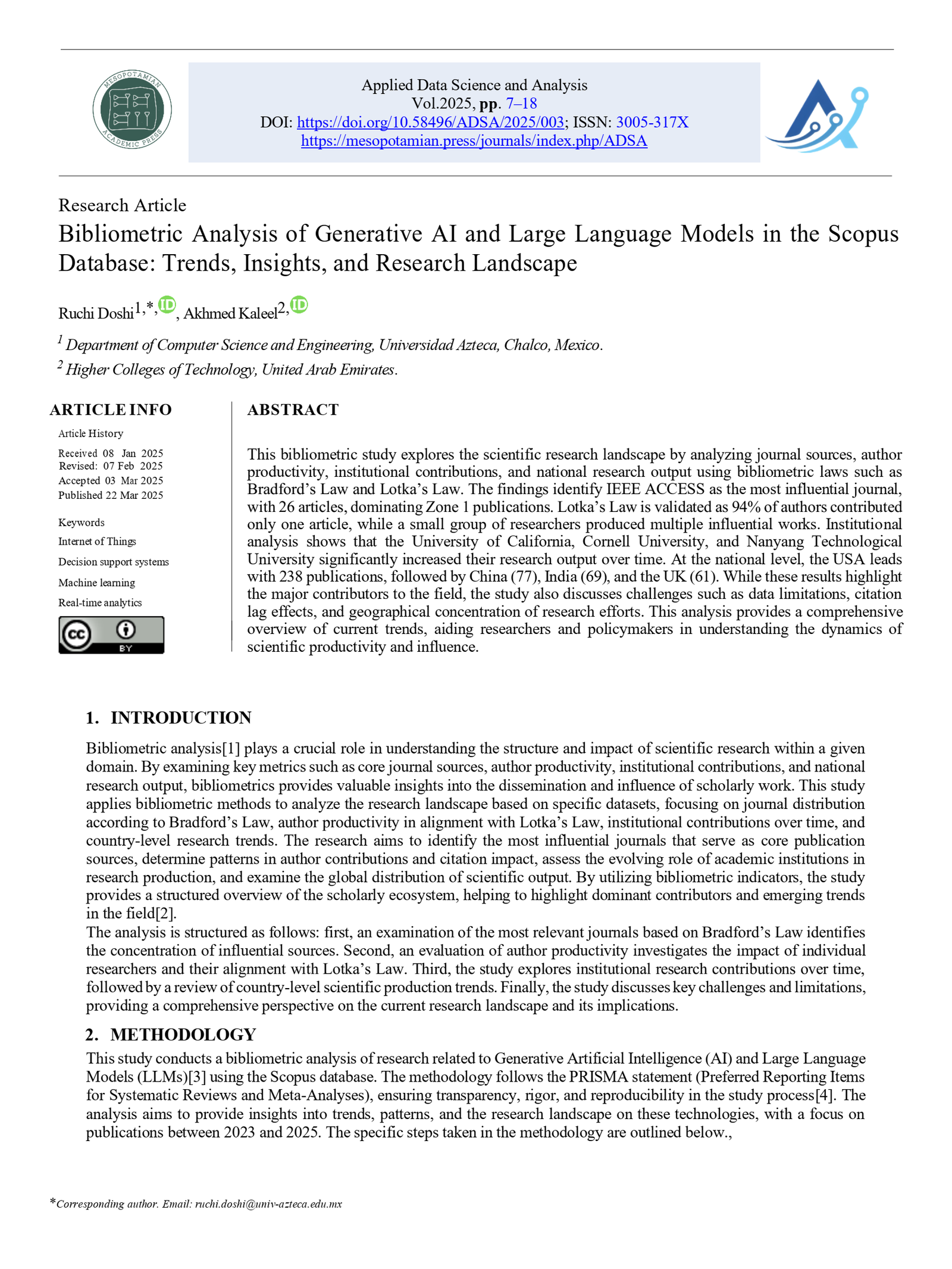Bibliometric Analysis of Generative AI and Large Language Models in the Scopus Database: Trends, Insights, and Research Landscape
Main Article Content
Abstract
This bibliometric study explores the scientific research landscape by analyzing journal sources, author productivity, institutional contributions, and national research output using bibliometric laws such as Bradford’s Law and Lotka’s Law. The findings identify IEEE ACCESS as the most influential journal, with 26 articles, dominating Zone 1 publications. Lotka’s Law is validated as 94% of authors contributed only one article, while a small group of researchers produced multiple influential works. Institutional analysis shows that the University of California, Cornell University, and Nanyang Technological University significantly increased their research output over time. At the national level, the USA leads with 238 publications, followed by China (77), India (69), and the UK (61). While these results highlight the major contributors to the field, the study also discusses challenges such as data limitations, citation lag effects, and geographical concentration of research efforts. This analysis provides a comprehensive overview of current trends, aiding researchers and policymakers in understanding the dynamics of scientific productivity and influence.
Article Details
Issue
Section

This work is licensed under a Creative Commons Attribution 4.0 International License.
Deprecated: json_decode(): Passing null to parameter #1 ($json) of type string is deprecated in /home/u273879158/domains/mesopotamian.press/public_html/journals/plugins/generic/citations/CitationsPlugin.php on line 68
How to Cite
References
[1] R. Dwivedi and L. Elluri, "Exploring Generative Artificial Intelligence Research: A Bibliometric Analysis Approach," IEEE Access, 2024.
[2] N. Khan, Z. Khan, A. Koubaa, M. K. Khan, and R. B. Salleh, "Global insights and the impact of generative AI-ChatGPT on multidisciplinary: a systematic review and bibliometric analysis," Connection science, vol. 36, no. 1, p. 2353630, 2024.
[3] V. Malele, "Evaluations of Large Language Models a Bibliometric analysis," The Indonesian Journal of Computer Science, vol. 13, no. 1, 2024.
[4] T. A. Litvinova, G. K. Mikros, and O. V. Dekhnich, "Writing in the era of large language models: a bibliometric analysis of research field," Научный результат. Вопросы теоретической и прикладной лингвистики, vol. 10, no. 4, pp. 5-16, 2024.
[5] L. Fan, L. Li, Z. Ma, S. Lee, H. Yu, and L. Hemphill, "A bibliometric review of large language models research from 2017 to 2023," ACM Transactions on Intelligent Systems and Technology, vol. 15, no. 5, pp. 1-25, 2024.
[6] G. Gencer and K. Gencer, "Large Language Models in Healthcare: A Bibliometric Analysis and Examination of Research Trends," Journal of Multidisciplinary Healthcare, pp. 223-238, 2025.
[7] N. Fijačko et al., "Using generative artificial intelligence in bibliometric analysis: 10 years of research trends from the European Resuscitation Congresses," Resuscitation Plus, vol. 18, p. 100584, 2024.
[8] G. Marchena Sekli, "The research landscape on generative artificial intelligence: a bibliometric analysis of transformer-based models," Kybernetes, 2024.
[9] A. A. Lopes, "Generative artificial intelligence in health professions: a bibliometric descriptive analysis," in INTED2024 Proceedings, 2024, pp. 7384-7389: IATED.
[10] P. K. Nashiroh and R. Iskandar, "Bibliometric analysis: Learning using generative AI," Journal of Research in Instructional, vol. 4, no. 1, pp. 194-204, 2024.
[11] C. Ganjavi et al., "Bibliometric analysis of publisher and journal instructions to authors on generative-AI in academic and scientific publishing," arXiv preprint arXiv:2307.11918, 2023.
[12] N. Wang, S. Li, C. Wang, and L. Zhao, "Current Status and Emerging Trends of Generative Artificial Intelligence Technology: A Bibliometric Analysis," Journal of Internet Technology, vol. 25, no. 3, pp. 477-485, 2024.
[13] J. S. de Cerqueira, K.-K. Kemell, R. Rousi, N. Xi, J. Hamari, and P. Abrahamsson, "Mapping Trustworthiness in Large Language Models: A Bibliometric Analysis Bridging Theory to Practice," arXiv preprint arXiv:2503.04785, 2025.
